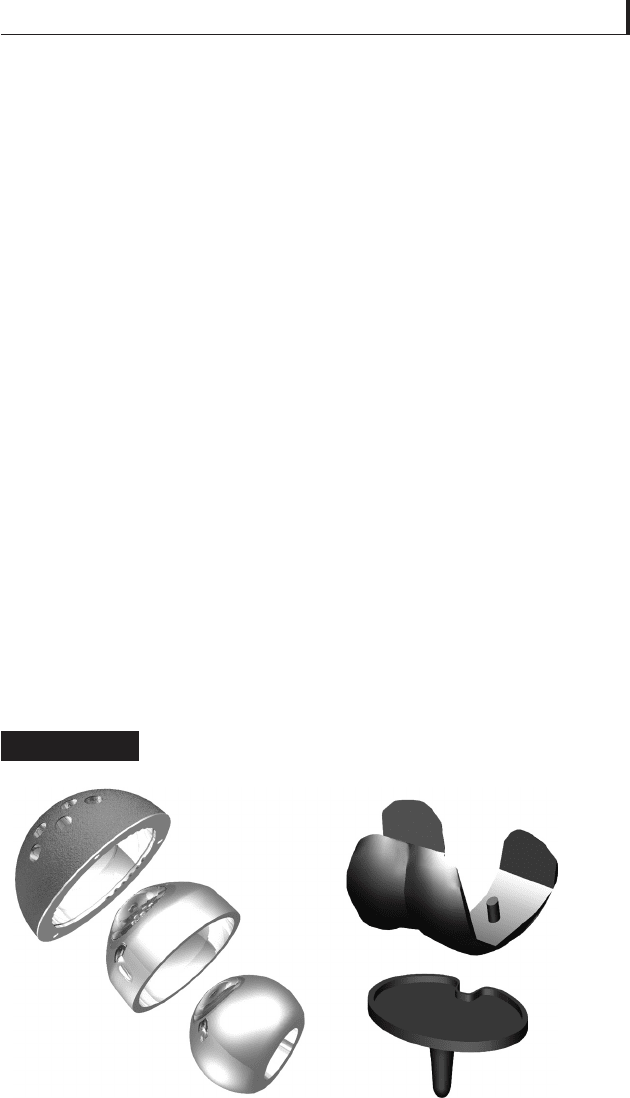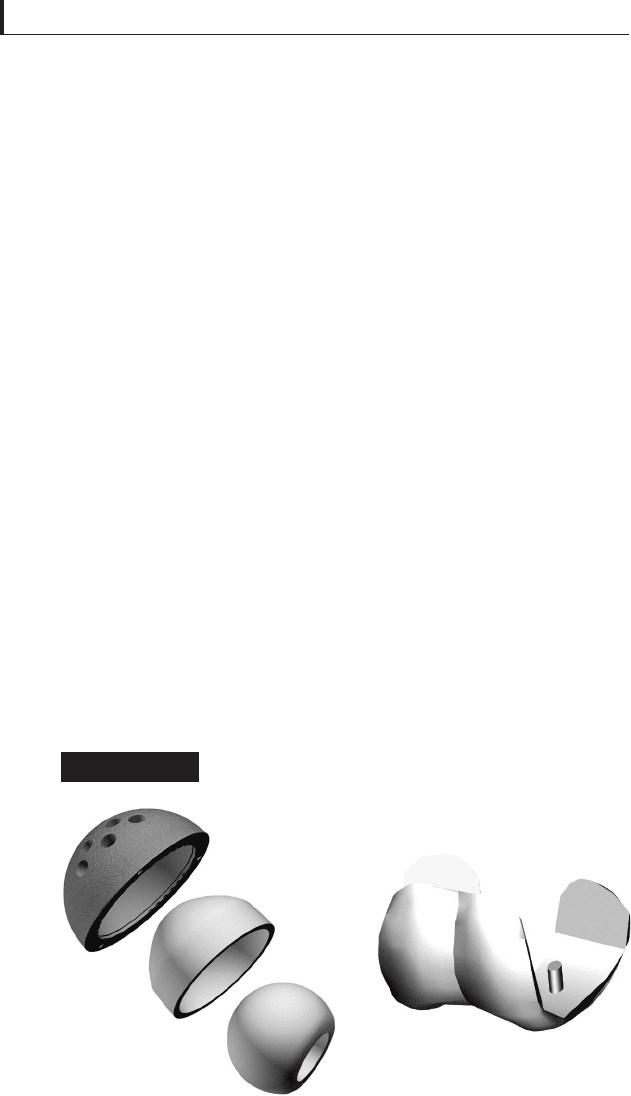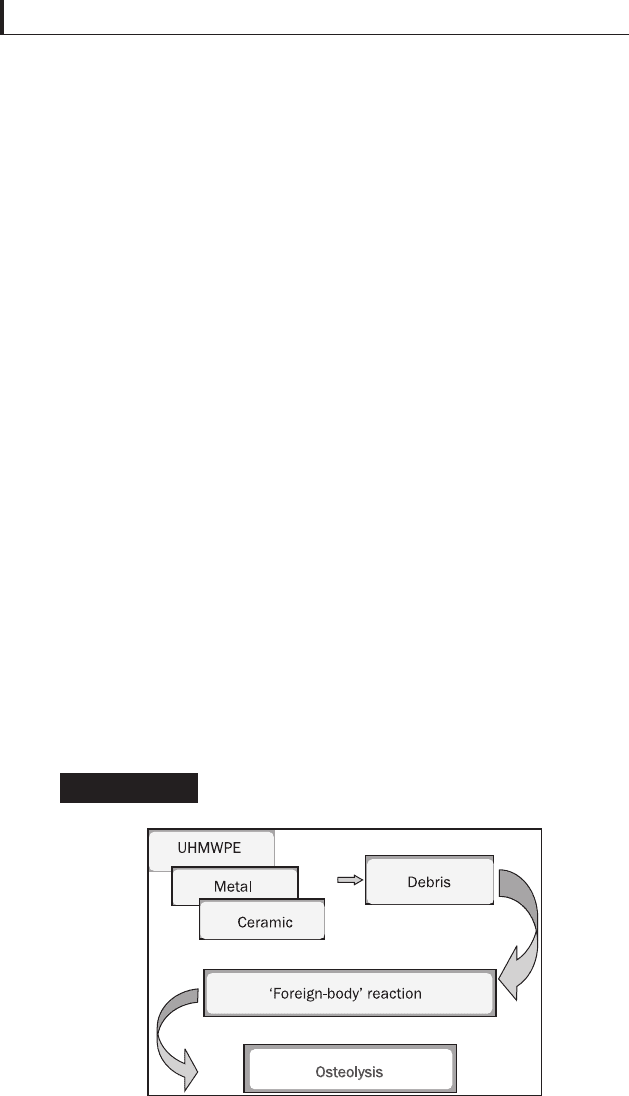Davim J.P. Tribology for Engineers: A Practical Guide
Подождите немного. Документ загружается.


260
Tribology for Engineers
200,000 ethylene repeat units. In general terms, after the
polymerization from ethylene gas, UHMWPE in the form of
resin powder needs to be consolidated in the form of sheet,
rod or in the form of near net implant. Finally, in most
instances, the UHMWPE implant must be machined into its
fi nal shape (Kurtz, 2004). UHMWPE is a semi-crystalline,
two-phase viscoplastic solid composed of an amorphous
matrix responsible for the resistance to mechanical
deformations, embedding crystalline domains (Renò and
Cannas, 2006). The crystalline phase consists of folded rows
of carbon atoms packed into lamellae. The surrounding
amorphous phase consists of randomly oriented and
entangled polymer chains traversed by tie molecules, which
interconnect lamellae that provide resistance to mechanical
deformation. UHMWPE can evolve over time in response to
its mechanical, chemical and thermal history. It has long
been known that processing can substantially infl uence the
morphology, and hence the mechanical behaviour of
UHMWPE (Edidin et al., 1999; Reggiani et al., 2006).
Crosslinking has been extensively introduced to reduce the
wear of UHMWPE. Following the identifi cation of the
acceleration of wear due to oxidative degradation of
UHMWPE which had been gamma sterilized in air, stabilized
UHMWPE (which is irradiated in an inert atmosphere) and
intentionally crosslinked UHMWPE have been developed
and introduced clinically (Wikipedia, 2007; Jacobson, 2008).
Whereas cross linking is essential for reducing abrasive and
adhesive wear, elimination of the free radicals is an important
step in reducing the long-term oxidative degradation and
embitterment of the UHMWPE, but UHMWPE introduces
other modes of damage such as delamination and fatigue,
which could adversely affect the device performance (Shen
and McKellop, 2002; Anonymous, 2008).

261
Bio and medical tribology
6.4.2 Metal
The metal-on-metal (MOM) concept was introduced in the
1960s as the so-called McKee–Farrar prosthesis. It was
introduced to solve the critical problems of polyethylene
wear (Rose et al., 1980; Willmann, 1998) and Fig. 6.5 shows
some components.
MOM articulation is typically associated with the cobalt-
chromium-molybdenum alloy (CoCrMo according to ISO
5832-4). Typically, these alloys are divided into two
categories: high carbon alloys, where the C content is above
0.20%; and low-carbon alloys (carbon content < 0.08%)
(standard ASTM F75-07).
CoCrMo implants can be manufactured using two different
techniques: casting and forging. The grain size of the forged
alloy is typically less than 10 μm, whereas the grain size of
the cast material ranges from 30 to 1000 μm (Asphahani,
1987; Wang et al., 1999). The carbides are also smaller in
forged components than in the cast components. The effects
of these variations in material in the manufacturing process
Metallic components used in hip and knee
orthopaedics implants
Figure 6.5

262
Tribology for Engineers
have effects on the wear rate, on the production of particles
debris, and on the micro-structure of the CoCrMo alloy
(Tipper et al., 2005). A high carbon content improves wear
resistance in cast implants because it increases material
hardness (Mcminn, 2003) while a low carbon content is
preferable with forged components (Chan et al., 1996,
1999). However, even if low carbon metal-on-metal bearings
have demonstrated a good in vitro tribological behaviour,
the clinical behaviour seems to be considerably worst than
high carbon metal-on-metal bearings.
Very large grains, as can occur in cast cobalt-chromium
alloy, decrease yield strength which can lead to catastrophic
failure in load-bearing implants; in addition, the large carbides
typical of these alloys can also be removed from the surface,
creating third body wear conditions (Asphahani, 1987;
Mancha et al., 1996). Corrosion of metals is the most obvious
form of degradation (Morais et al., 1998, 1999), and this is
defi ned as the unwanted chemical reaction of a metal with its
environment, resulting in its continued degradation to oxides,
hydroxides or other compounds (Black, 1996). Moreover
microstructure, morphology, carbide fraction, and diameter
size may all infl uence wear rate and corrosion properties of
base alloys (Marti, 2000; Buscher et al., 2005; Saldivar-
Garcia and Lopez, 2005). The goal of MOM-bearing
combinations is to reduce wear to less than a clinically
relevant level, that is a level that does not induce osteolysis or
another outcome that necessitates revision surgery.
A number of clinical studies have shown that some of these
MOM prostheses can last twenty or even up to thirty years,
while others can fail relatively early (Wimmer et al., 2003).
In 1988, the Metasul second-generation MOM hip prosthesis
was introduced into clinical practice, comprised of a cobalt
chrome alloy femoral head articulating on a cobalt-chromium
alloy acetabular cup. Over 200,000 Metasul combinations

263
Bio and medical tribology
have been implanted to date (Tipper et al., 2005) and short-
term clinical performance has been encouraging, with low
wear rates and few prostheses requiring revision.
Metals react with the oxygen-rich biological environment
and form a thin protective oxidative coating generally 2–5 nm
thick (Wikipedia, 2010a) that prevents corrosion. The
oxidative fi lm forms instantly once exposed to the in vivo
conditions, but is not permanently fi xated on the metals. The
coatings are capable of being scratched or rubbed off when
undergoing surface contact and once the coating is dissipated,
the implant metals are susceptible to releasing metal ions and
particulates. The presence of the particulate and ions creates
third body wear that dramatically increases wear rates due to
the substantial increase in roughness. This detrimental cycle
applied to the coating, to the metal ions released, and to the
reformation of new coatings is referred to as oxidative wear
(Davidson, 1993). While metallic implants show ion release
of various types, ceramics show no signs thereof. The highest
ion release was shown by stainless steel (SS 316). In vitro
testing and examination of retrieved implants and synovial
fl uid suggest that modern metal-on-metal bearings produce
minimal early wear and a lower incidence of periprosthetic
osteolysis than metal-on-polyethylene implants (Savarino
et al., 2006).
6.4.3 Ceramic
Ceramic materials for orthopaedic applications are a class of
new engineering materials for wear resistant applications
under severe environments. In the fi eld of materials science,
the term ‘ceramic’ includes all non-metallic, inorganic
materials; this word is derived from the Greek,
κεραμοσ
and
includes glass products, cement and plasters, some abrasive
and cutting tool materials, various electrical insulation

264
Tribology for Engineers
materials, porcelain and other refractory coatings for metals,
etc. (Ravaglioli and Krajewski, 1992; Hsu, 1996). Ceramic
materials for hip joints were introduced more than thirty
years ago to solve the critical problems of polyethylene wear
(Cuckler et al., 1995; Toni et al., 1995) and the fi rst ceramic-
on-ceramic coupling was implanted in France by Dr. Boutin
(Boutin, 1972).
Interest in ceramics for biomedical applications has increased
over the last thirty years and the properties to use these
materials for an orthopaedic application follows the
international guideline ISO 6474-10. The ceramics that are
used in implantation and clinical purposes include aluminium
oxide (alumina), partially stabilized zirconia (PSZ) (both
yttria tetragonal zirconia polycrystal [Y-TZP] and magnesia
partially stabilized zirconia [Mg-PSZ]), bioglass®, glass-
ceramics, calcium phosphates (hydroxyapatite and β-tricalcium
phosphate) and crystalline or glassy forms of carbon and its
compounds. Figure 6.6 shows some components.
The theoretical advantages of alumina ceramic are related
to the excellent biocompatibility, exceptional tribological
Ceramic components used in hip and knee
orthopaedics implants
Figure 6.6

265
Bio and medical tribology
properties due to high scratch resistance and wettability of
the material, good properties of mechanical and wear
resistance, good properties at high temperatures where metals
cannot be used, and chemical stability (McKellop et al., 1992;
Toni et al., 1995; Hsu, 1996; Willmann, 1998). Zirconia
ceramics have been introduced into orthopaedics as an
alternative to alumina (Derbyshire et al., 1994). They have
several advantages over other ceramic materials due to the
transformation toughening mechanisms operating in their
microstructure that give their components very interesting
mechanical properties (Piconi and Maccauro, 1999). Alumina
is chemically more stable but it is mechanically weaker
than zirconia; however, the degradation of zirconia, in
which the phase transformation is accelerated in an aqueous
environment, is a limitation to this material in bioceramic use
(Piconi et al., 1998; Piconi and Maccauro, 1999).
Current commercially available components are generally
composed of a single medical grade ceramic, therefore
scientists developed the idea of combining alumina and
zirconia in different percentages. A fraction of zirconia added
to alumina reduces the incidence of fracture and results in a
composite material of increased toughness (Cherif et al., 1996;
Affatato et al., 1999, 2001; Piconi and Maccauro, 1999). This
may be a particular solution to obtain a new material with
improved mechanical and tribological properties than the
pure ceramics components, commonly perceived as rigid and
subject to brittle fracture. Biolox Delta is the brand name of
this third generation of ceramics in which the resistance and
toughness of alumina is combined with the resistance and
toughness of zirconia in order to create a composite material
with good biocompatibility, chemical and hydrothermal
stability, high resistance to wear and good mechanical features
(toughness and strength) (Dalla Pria and Burger, 2003;
Benazzo et al., 2007).

266
Tribology for Engineers
6.5 Wear of biomaterials
Material selection and component design are important
factors in the performance and durability of total joint
replacements but, unfortunately, wear of hip and knee
bearings exist and is a signifi cant clinical problem. The wear
of the implant products can cause adverse tissue reaction
that may lead to massive bone loss around the implant and
consequently loosening of the fi xation. A schematization of
this phenomenon is better emphasized in Fig. 6.7.
The tribological interactions of a solid surface’s exposed
face with interfacing materials and environment may result
in loss of material from the surface, known as ‘wear’. Wear
is the erosion of material from a solid surface by the action
of another surface. It is related to surface interactions and
more specifi cally to the removal of material from a surface as
a result of mechanical action (Rabinowicz, 1995; Czichos,
1997). Wear can be minimized by modifying the surface
properties of solids by one or more surface fi nishing or by
use of lubricants (for frictional or adhesive wear), but
any material can wear by a lot of movement infl uenced by
Schematization of osteolysis phenomenon due
to wear and particles debris
Figure 6.7

267
Bio and medical tribology
factors such as ambient conditions, temperature, loading,
counterface, etc. (Bayer, 1997). Many physical wear
mechanisms exist and it must be emphasized that there is
more than one distinct mechanism of wear, with sensitivity
to parameters such as load, speed, etc., being different for
different wear situations (Bayer, 1997). Major types of wear
include abrasion, adhesion (friction), erosion, fretting, and
corrosion.
■ Abrasion: Abrasive wear occurs when a hard rough
surface slides across a softer surface. In other words it
is defi ned as the loss of material due to hard particles
or hard protuberances that are forced against and move
along a solid surface (Rabinowicz, 1995 and standard
ASTM-G40, 2009). Abrasive wear is commonly
classifi ed according to the type of contact and the contact
environment. The two modes of abrasive wear are known
as two-body and three-body abrasive wear. Two-body
wear occurs when the grits, or hard particles, are rigidly
mounted or adhere to a surface, and material is removed
from the surface. The common analogy is that of material
being removed with sandpaper. Three-body wear occurs
when the particles are not constrained, and are free to
roll and slide down a surface. The contact environment
determines whether the wear is classifi ed as open or
closed. An open contact environment occurs when the
surfaces are suffi ciently displaced to be independent of
one another (Wikipedia, 2010d).
■ Adhesion: The tendency of certain dissimilar molecules
to cling together due to attractive forces. Adhesive wear
occurs when two bodies slide over each other, or are
pressed into one another, which promote material
transfer between the two surfaces. However, material
transfer is always present when two surfaces are aligned

268
Tribology for Engineers
against each other for a certain amount of time
(Rabinowicz, 1995; Wikipedia, 2010d).
■ Erosion: A gravity driven process that moves solids
(sediment, soil, rock and other particles) in the natural
environment or their source and deposits them elsewhere
(Wikipedia, 2009). It usually occurs due to transport by
wind, water, or ice; by down-slope creep of soil and other
material under the force of gravity; or by living organisms,
such as burrowing animals, in the case of bio-erosion. The
impacting particles gradually remove material from the
surface through repeated deformations and cutting actions.
■ Fretting wear: The repeated cyclical rubbing between
two surfaces, which is known as fretting, over a period
of time which will remove material from one or both
surfaces in contact (Wikipedia, 2008). It occurs typically
in bearings, although most bearings have their surfaces
hardened to resist the problem. Another problem occurs
when cracks in either surface are created, known as
fretting fatigue. It is the more serious of the two
phenomena because it can lead to catastrophic failure of
the bearing.
■ Corrosion: The disintegration of an engineered material
into its constituent atoms due to chemical reactions with
its surroundings (Anonymous, 2010a). In the most
common use of the word, this means electrochemical
oxidation of metals in reaction with an oxidant such as
oxygen. Formation of an oxide of iron due to oxidation
of the iron atoms in solid solution is a well-known
example of electrochemical corrosion, commonly known
as rusting, and this type of damage typically produces
oxide(s) and/or salt(s) of the original metal. Corrosion
can also refer to other materials than metals, such as
ceramics or polymers, although in this context the term

269
Bio and medical tribology
degradation is more common. In other words, corrosion
is the wearing away of metals due to a chemical reaction.
6.6 Wear evaluation
Wear is not a basic material property, but a system response
of materials. The America Society for Testing and Materials
(ASTM) defi ne in a standard guideline (ASTM G40-10)
that ‘wear is defi ned as damage to a solid surface, generally
involving progressive loss of material . . .’. This statement
means that the surfaces of any material can alter and damage
because of an alteration to them. A single general-purpose
wear test that establishes a unique wear parameter or rating
of a material does not exist, so to assess the amount of wear,
several approaches have been used to determine its value and
to prescribe appropriate solution. Scientists have used wear
testing in order to rank wear resistance of materials, and
complex methods of wear testing were developed in order to
determine wear parameters that can project performance
and to establish the infl uence of various factors on these
parameters (Bezing, 1973; Bayer, 1997).
Wear simulation is an essential pre-clinical method to
predict the mid- and long-term clinical wear behaviour of
prosthesis, and one of the most important aspects of wear
testing is simulation of actual wear conditions. Generally,
two categories of laboratory tests are conducted: wear-
screening devices and wear joint devices.
6.6.1 Wear screening devices
These categories of tests, also called quick-tests, provide
information exclusively on the intrinsic features of the
